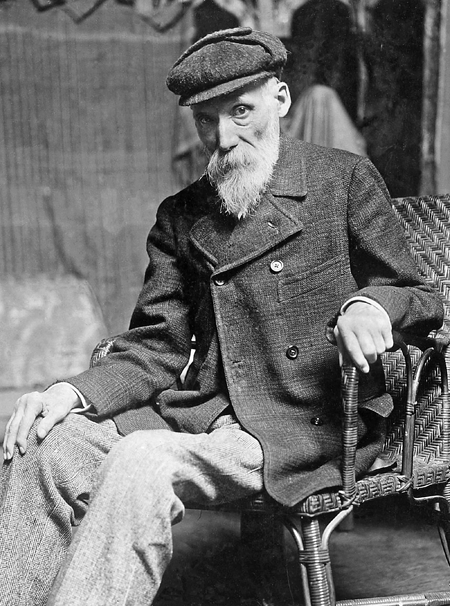
The city proper of Limoges, France was founded by the Romans around 10 B.C.. In the oceanic climate, where the porcelain industry developed, the birth of Pierre-Auguste Renoir February 25, 1841, was filed in the record books. His father, Leonard Renoir, was a tailor of modest means.

Dornac photo
In 1844 the family moved to Paris in hopes of more favorable prospects. The young Renoir had a beautiful singing voice and a natural proclivity for drawing. Due to the family financial circumstances, Renoir had to discontinue his music lessons and leave school at the age of 13 to pursue an apprenticeship at a porcelain factory.
He had a talent for the work, but it bored him and he sought refuge in the galleries of the Louvre. He enrolled into the Ecole des Beaux Arts school. He painted hangings for overseas missionaries and decorations on fans to support himself. There were times in the 1860s that he did not have enough money to buy paint. Counterpoint to this fact is that in 2014 at various auction houses, his paintings sold for up to $3.5 Million.
One of his first successes was at the Salon of 1868 with his painting “Lise with a Parasol” done in 1867. The painting depicted Lise Trehot, his lover at that time. He painted on the banks of the Seine River. Some Communards thought he was a spy during the Franco-Prussian War and wanted to throw him into the River. A leader of the Commune Raoul Rigault recognized Renoir as the man who had protected him on an earlier occasion and stopped the madness.
Renoir met Claude Monet, Frédéric Bazille, and Alfred Sisley while studying art under Charles Gleyre in Paris. He took many trips to study other masters: To Algeria, to Madrid, to Florence, to Sicily. In 1883 he spent the Summer in Guernsey with its varied landscape of beaches, cliffs, and bays. He created 15 paintings in one month there. Those paintings were the subject of a set of commemorative postage stamps issued by the Bailiwick of Guernsey in 1983.
At the second Impressionist exhibition in 1876 he displayed portraits. The portrait commissions gave him his livelihood. By the Salon of 1879, Renoir had become a successful and fashionable painter.
When Queen Victoria celebrated her Golden Jubilee in 1887, Renoir donated several paintings to the “French Impressionist Paintings” catalog as a token of his loyalty. In 1890 he married Aline Victorine Charigot, a dressmaker 20 years his junior. Renoir had three sons, Pierre, Jean, and Claude. He was to paint many scenes of his wife and daily family life.
Approximately in 1892 Renoir developed rheumatoid arthritis. In 1907 the family moved to the warmer climate of “Les Collettes,” a farm close to the Mediterranean Coast. For the next 20 years he painted even in the advanced stages of the arthritis. A brush would be strapped to his paralyzed fingers. His hands were wrapped with bandages to prevent skin irritation.
Luckily, in 1919, Renoir visited the Louvre to see his paintings hanging with those of the old masters. He created sculptures during this time by cooperating with a young artist, Richard Guino, who worked the clay. His paintings were notable for their vibrant light and saturated color, most often focusing on people in intimate and candid compositions. Renoir possessed great talent and gave the world several thousand stylistic Impressionist paintings. The single largest collection of his works, 181 paintings, is housed at the Barnes Foundation in Philadelphia.
Pierre-Auguste Renoir died in the village of Cagnes-sur-Mer, Provence-Alpes-Cote d’ Azur on December 3, 1919 at age 78.

